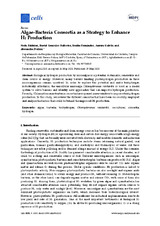Algae-Bacteria Consortia as a Strategy to Enhance H2 Production
Autor
Fakhimi, Neda
González-Ballester, David
Fernández, Emilio
Galván Cejudo, Aurora
Dubini, Alexandra
Editor
MDPIFecha
2020Materia
AlgaeBacteria
Biohydrogen
Chlamydomonas reinhardtii
Co-cultures
Consortia
Hydrogen
METS:
Mostrar el registro METSPREMIS:
Mostrar el registro PREMISMetadatos
Mostrar el registro completo del ítemResumen
Biological hydrogen production by microalgae is a potential sustainable, renewable and clean source of energy. However, many barriers limiting photohydrogen production in these microorganisms remain unsolved. In order to explore this potential and make biohydrogen industrially affordable, the unicellular microalga Chlamydomonas reinhardtii is used as a model system to solve barriers and identify new approaches that can improve hydrogen production. Recently, Chlamydomonas–bacteria consortia have opened a new window to improve biohydrogen production. In this study, we review the different consortia that have been successfully employed and analyze the factors that could be behind the improved H2 production.

